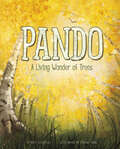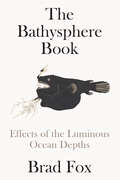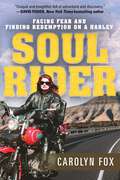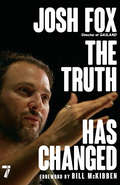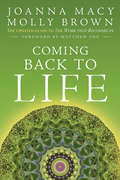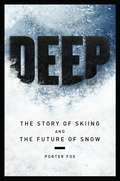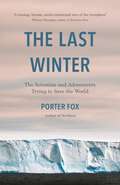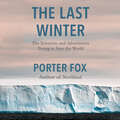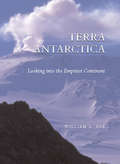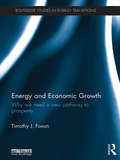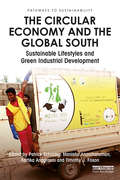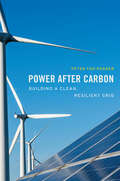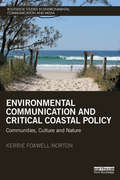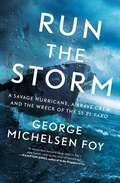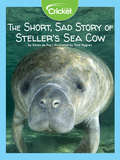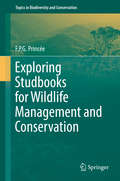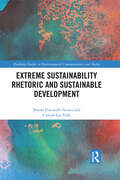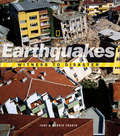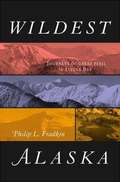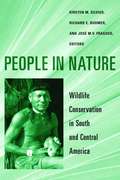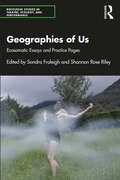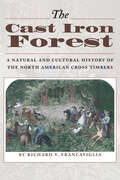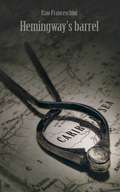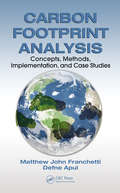- Table View
- List View
Pando: A Living Wonder of Trees
by Author Kate Allen FoxPando is an inspiring tribute to a Utah grove of quaking Aspen trees connected by their roots to form one of the world's oldest and largest living things. Author Kate Allen Fox engages readers’ senses to help convey the vastness of Pando, the challenges it faces, and how we all can be part of the solution. With lyrical poetry, Fox summarizes the science, action, and compassion needed to save this wonder of nature.
The Bathysphere Book: Effects of the Luminous Ocean Depths
by Brad Fox"Hypnotic . . . Beautifully written and beautifully made." —W. M. Akers, The New York Times Book Review"Mesmerizing . . . Original and often profound, [The Bathysphere Book] is a moving testament to the wonders of exploration."—Publishers Weekly, Starred Review "Imbued with the adventurous spirit of science and exploration . . . [The Bathysphere Book is] an enchanting cabinet of curiosities." —Kirkus Reviews A wide ranging, philosophical, and sensual account of early deep sea exploration and its afterlives, The Bathysphere Book begins with the first ever voyage to the deep ocean in 1930 and expands to explore the adventures and entanglements of its all-too-human participants at a time when the world still felt entirely new.In the summer of 1930, aboard a ship floating near the Atlantic island of Nonsuch, marine biologist Gloria Hollister sat on a crate, writing furiously in a notebook with a telephone receiver pressed to her ear. The phone line was attached to a steel cable that plunged 3,000 feet into the sea. There, suspended by the cable, dangled a four-and-a-half-foot steel ball called the bathysphere. Crumpled inside, gazing through three-inch quartz windows at the undersea world, was Hollister&’s colleague William Beebe. He called up to her, describing previously unseen creatures, explosions of bioluminescence, and strange effects of light and color.From this momentous first encounter with the unknown depths, The Bathysphere Book widens its scope to explore a transforming and deeply paradoxical America, as the first great skyscrapers rose above New York City and the Great Plains baked to dust. In prose that is magical, atmospheric, and entirely engrossing, Brad Fox dramatizes new visions of our planetary home, delighting in tales of the colorful characters who surrounded, supported, and participated in the dives—from groundbreaking scientists and gallivanting adventurers to eugenicist billionaires.The Bathysphere Book is a hypnotic assemblage of brief chapters along with over fifty full-color images, records from the original bathysphere logbooks, and the moving story of surreptitious romance between Beebe and Hollister that anchors their exploration. Brad Fox blurs the line between poetry and research, unearthing and rendering a visionary meeting with the unknown.
Soul Rider: Facing Fear and Finding Redemption on a Harley
by Carolyn FoxThis is the story of a woman who went on an incredible journey. Carolyn Fox was a single mother and lawyer haunted with grief and secrets, and facing her fiftieth birthday. So she decided to change her life by facing her fears: she bought a Harley, packed it with a sleeping bag and tent, and set out to ride through all fifty states-alone! Soul Rider is her gripping travel/journey memoir, written by a successful woman who realized she would have to make significant changes in the way she lived and thought, if she ever had a chance to find peace and wholeness. Soul Rider will inspire readers to:Believe they can improve the quality of their lives by stepping outside their comfort zonesFind the courage to ask for forgiveness - first by forgiving others, and then by forgiving themselvesRecognize that loneliness can be overcome, simply by being the first to say HelloLearn that it’s okay to admit failures, fears, and guilt. Stuff happens to everyone. Confront those things and discover how quickly personal empowerment flows.Along the way, Carolyn traveled alone but met colorful characters, received positive media attention, discovered who she was, and put more than 14,000 miles on her bike. She kept a journal of her adventures, and the result is Soul Rider.
The Truth Has Changed
by Josh FoxThe Emmy Award–winning creator of GASLAND tells his intimate and damning, personal story of our world in crisis. With a foreword by Bill McKibben. The rules have changed. The water has changed. The climate has changed. The truth has changed. We must change. In The Truth Has Changed, Josh Fox turns the rapid-fire shocks that are remaking the very fabric of our lives—writing as a first responder, a reporter, a documentarian, and an activist—into art, literature, and at least one answer to the question of what the future holds. Our normal isn’t normal anymore. The paradigm shift that global warming represents parallels a paradigm shift in how we process truth. Both deeply affect democracy. Josh Fox has had a front row seat—a first responder after 9/11, filming the Deepwater Horizon spill close up from the air and on the ground, a member of Bernie Sanders’s delegation of the Democratic Platform Committee, risking his life to cross a bridge on Thanksgiving Day at Standing Rock, traveling the nation and the world, shooting his films, talking to people everywhere he goes. The Truth Has Changed is his first book, the companion to his new one-man show of the same title, and it’s beautiful.
Coming Back to Life: The Updated Guide to The Work that Reconnects
by Matthew Fox Molly Young Brown Joanna MacyDeepening global crises surround us. We are beset by climate change, fracking, tar sands extraction, GMOs, and mass extinctions of species, to say nothing of nuclear weapons proliferation and Fukushima, the worst nuclear disaster in history. Many of us fall prey to despair even as we feel called to respond to these threats to life on our planet.Authors Joanna Macy and Molly Brown address the anguish experienced by those who would confront the harsh realities of our time. In this fully updated edition of Coming Back to Life, they show how grief, anger, and fear are healthy responses to threats to life, and when honored can free us from paralysis or panic, through the revolutionary practice of the Work that Reconnects. New chapters address working within the corporate world, and engaging communities of color as well as youth in the Work.The Work that Reconnects has spread around the world, inspiring hundreds of thousands to work toward a life-sustaining human culture. Coming Back to Life introduces the Work's theoretical foundations, illuminating the angst of our era with extraordinary insight. Pointing the way forward out of apathy, it offers personal counsel as well as easy-to-use methods for group work that profoundly affect peoples' outlook and ability to act in the world.Joanna Macy is a scholar, eco-philosopher, teacher, activist, and author of twelve previous books including Coming Back to Life.Molly Young Brown is a teacher, trainer, counselor, and author of four previous books on psychology and Earth-based spirituality.
Deep: The Story of Skiing and the Future of Snow
by Porter FoxIn his stunning first book, veteran ski writer Porter Fox captures the 8,000-year-old sport of skiing, the miracle of snow and the shocking truth of how climate change could wipe out both in the next 75 years. The narrative follows the unlikely rise of skiing from prehistoric Norwegian hunters to nobility in the Alps in the 1800s to present-day freeriders on the vaunted slopes of the Rocky Mountains. On his global tour of the most celebrated mountains in the Northern Hemisphere from Washington's Cascade Range to the European Alps. Fox talks to alpinists about the allure and mysticism of the sport and to scientists about climate change and its effect on snow ultimately finding a story that is far larger than the demise of skiing.
The Last Winter: The Scientists and Adventurers Trying to Save the World
by Porter FoxAs the planet warms, winter is shrinking. In the last fifty years, the Northern Hemisphere lost a million square miles of spring snowpack, and high-elevation snowpacks in the western United States have decreased by nearly half since 1982. On average, winter has shrunk by a month in most northern latitudes.In this deeply researched, beautifully written, and adventure-filled book, journalist Porter Fox travels along the edge of the Northern Hemisphere's snow line to track the scope of this drastic change and how it will literally change everything-from rapid sea level rise, to fresh water scarcity for two billion people, to massive greenhouse gas emissions from thawing permafrost, and several climate tipping points that could very well spell the end of our world.This original research is animated by four harrowing and illuminating journeys-each grounded by interviews with idiosyncratic, charismatic experts in their respective fields and Fox's own narrative of growing up on a remote island in northern Maine.Timely, atmospheric, and expertly investigated, The Last Winter showcases a shocking and unexpected casualty of climate change-which may well set off its own unstoppable warming cycle.
The Last Winter: The Scientists and Adventurers Trying to Save the World
by Porter FoxAs the planet warms due to greenhouse gas emissions, winter as we know it is disappearing. In the last fifty years, the Northern Hemisphere lost a million square miles of spring snowpack and in the US alone, snow cover has been reduced by 15-30%. On average, winter has shrunk by a month in most northern latitudes.In this deeply researched and adventure-filled book, journalist Porter Fox travels along the edge of the Northern Hemisphere's snow line to track the scope of this drastic change, and ultimately, predict what the future of winter-or lack thereof-will look like.This original research will be animated by five harrowing and illuminating journeys- each grounded by interviews with idiosyncratic, charismatic experts in their respective fields and Fox's own narrative of growing up on a remote island in Northern Maine.Timely, atmospheric, and expertly investigated, THE LAST WINTER will showcase like never before the true cost of climate change.(P) 2021 Headline Publishing Group Limited
Terra Antarctica
by William FoxHow does the human mind transform space into place, or land into landscape? For more than three decades, William L. Fox has looked at empty landscapes and the role of the arts to investigate the way humans make sense of space. In Terra Antarctica, Fox continues this line of inquiry as he travels to the Antarctic, the "largest and most extreme desert on earth." This contemporary travel narrative interweaves artistic, cartographic, and scientific images with anecdotes from the author's three-month journey in the Antarctic to create an absorbing and readable narrative of the remote continent. Through its images, history, and firsthand experiences-snowmobile trips through whiteouts and his icy solo hikes past the edge of the mapped world-Fox brings to life a place that few have seen and offers us a look into both the nature of landscape and ourselves.
Terra Antarctica
by William FoxHow does the human mind transform space into place, or land into landscape? For more than three decades, William L. Fox has looked at empty landscapes and the role of the arts to investigate the way humans make sense of space. In Terra Antarctica, Fox continues this line of inquiry as he travels to the Antarctic, the "largest and most extreme desert on earth." This contemporary travel narrative interweaves artistic, cartographic, and scientific images with anecdotes from the author's three-month journey in the Antarctic to create an absorbing and readable narrative of the remote continent. Through its images, history, and firsthand experiences-snowmobile trips through whiteouts and his icy solo hikes past the edge of the mapped world-Fox brings to life a place that few have seen and offers us a look into both the nature of landscape and ourselves.
Energy and Economic Growth: Why we need a new pathway to prosperity (Routledge Studies in Energy Transitions)
by Timothy J. FoxonAccess to new sources of energy and their efficient conversion to provide useful work have been key drivers of economic growth since the industrial revolution. Western countries now need to transform their energy systems and move away from the single-minded pursuit of economic growth in order to reduce our carbon emissions, and to allow the environmental space for other countries to develop in a more sustainable way. Achieving this requires understanding of the dynamics of economic and industrial change with appreciation of the dependence of economies on ecological systems. Energy and Economic Growth thus examines the links between three issues: history of energy sources, technologies and uses; ecological challenges associated with the current dominant economic growth paradigm; and the future low carbon energy transition to mitigate human-induced climate change. Providing a historical understanding of the relevant connections between physical, social and economic changes, the book enables the reader to better understand the connection between their own energy use and global economic and environmental systems, and to be able to ask the right questions of our political and business leaders. This is a valuable resource for students, scholars and policy makers with an interest in energy, climate change and economic thinking.
The Circular Economy and the Global South: Sustainable Lifestyles and Green Industrial Development (Pathways to Sustainability)
by Timothy Foxon Patrick Schröder Manisha Anantharaman Kartika AnggraeniThe circular economy is a policy approach and business strategy that aims to improve resource productivity, promote sustainable consumption and production and reduce environmental impacts. This book examines the relevance of the circular economy in the context of developing countries, something which to date is little understood. This volume highlights examples of circular economy practices in developing country contexts in relation to small and medium enterprises (SMEs), informal sector recycling and national policy approaches. It examines a broad range of case studies, including Argentina, Brazil, China, Colombia, India, Indonesia, Kenya, South Africa, and Thailand, and illustrates how the circular economy can be used as a new lens and possible solution to cross-cutting development issues of pollution and waste, employment, health, urbanisation and green industrialisation. In addition to more technical and policy oriented contributions, the book also critically discusses existing narratives and pathways of the circular economy in the global North and South, and how these differ or possibly even conflict with each other. Finally, the book critically examines under what conditions the circular economy will be able to reduce global inequalities and promote human development in the context of the Sustainable Development Goals. Presenting a unique social sciences perspective on the circular economy discourse, this book is relevant to students and scholars studying sustainability in economics, business studies, environmental politics and development studies.
Power after Carbon: Building a Clean, Resilient Grid
by Peter Fox-PennerAs the electric power industry faces the challenges of climate change, technological disruption, new market imperatives, and changing policies, a renowned energy expert offers a roadmap to the future of this essential sector. As the damaging and costly impacts of climate change increase, the rapid development of sustainable energy has taken on great urgency. The electricity industry has responded with necessary but wrenching shifts toward renewables, even as it faces unprecedented challenges and disruption brought on by new technologies, new competitors, and policy changes. The result is a collision course between a grid that must provide abundant, secure, flexible, and affordable power, and an industry facing enormous demands for power and rapid, systemic change. The fashionable solution is to think small: smart buildings, small-scale renewables, and locally distributed green energy. But Peter Fox-Penner makes clear that these will not be enough to meet our increasing needs for electricity. He points instead to the indispensability of large power systems, battery storage, and scalable carbon-free power technologies, along with the grids and markets that will integrate them. The electric power industry and its regulators will have to provide all of these, even as they grapple with changing business models for local electric utilities, political instability, and technological change. Power after Carbon makes sense of all the moving parts, providing actionable recommendations for anyone involved with or relying on the electric power system.
Environmental Communication and Critical Coastal Policy: Communities, Culture and Nature (Routledge Studies in Environmental Communication and Media)
by Kerrie Foxwell-NortonThe vast majority of the world’s population lives on or near the coast. These communities are an extraordinary and largely untapped resource that can be used to mitigate planetary disaster and foster environmental stewardship. Repeated waves of scientific fact and information are not inciting action, nor apparently producing enough momentum to change voting behaviour towards a progressive environmental politics. A critical coastal policy, underpinned by a deeper understanding of environmental communication, can offer something new to this status quo. Environmental Communication and Critical Coastal Policy argues that more science and ‘better’ communication has been largely responsible for the lacklustre response by citizens to environmental challenges. Foxwell-Norton asserts that the inclusion of a range of local meanings and cultural frameworks with which experts could engage would better incite participation in, and awareness of, local environmental issues. The value and possible role of ‘geo-community media’ (mainstream, alternative and social media) is examined here to illustrate and support the key argument that meaningful local engagement is a powerful tool in coastal management processes. This is a valuable resource for postgraduates, researchers and academics across environmental science and management, policy studies, communication studies and cultural studies.
Run the Storm: A Savage Hurricane, a Brave Crew, and the Wreck of the SS El Faro
by George Michelsen Foy“Here is the pitch-perfect pairing of subject and author, a gripping deconstruction of one of recent history’s most terrible and vexing sea tragedies…A meticulous forensic study that, in Foy’s able hands, rises to the level of literature.” —Hampton Sides “Fans of The Perfect Storm and Into Thin Air will love this exquisitely written and dramatic book. George Foy has an action story that doesn’t quit.” —Doug Stanton “Foy is an experienced mariner who clearly knows his stuff, which gives the reader confidence in his account, and allows us to get lost in an amazing story that builds to a wild finish.” —John U. Bacon In the bestselling tradition of The Perfect Storm and The Finest Hours, a harrowing true account of the mysterious disappearance of the SS El Faro, a gigantic American cargo ship that sank in the Bermuda Triangle, taking with it thirty-three lives.On October 1, 2015, the SS El Faro, a massive American cargo ship that made regular runs between Jacksonville, Florida and Puerto Rico, delivering everything from deodorant to new Chevrolets, disappeared in Hurricane Joaquin, a category 4 storm. The ship, its hundreds of shipping containers, and its entire crew plummeted to the bottom of the ocean, three miles down. The sinking was the greatest seagoing US merchant marine shipping disaster since World War II. The massive ship had a seasoned crew, state-of-the-art navigation equipment, and advance warning of the storm. It seemed incomprehensible that such a ship could sink so suddenly. How, in this day and age, could something like this happen? The answer is that a ship as large as the El Faro doesn’t vanish for just one reason; it vanishes because many factors intersect—everything from hurricane-tracking algorithms to the decay of rubber gaskets on hatches to the arcane science of loading cargo containers to the psychology of a powerful ship’s captain. All of these factors and more came into play in the sinking of the El Faro. Relying on Coast Guard inquest hearings as well as on numerous interviews, George Michelsen Foy has crafted a brilliant account that brings to life the final voyage of El Faro, a story that lasts only a few days but which grows almost intolerably suspenseful as deep-rooted flaws leading to the disaster inexorably link together and worsen. We see captain, engineers, and crew fight for their lives, and hear their actual words (as recorded on the ship’s black box) while the hurricane relentlessly tightens its noose around the ship. We watch, minute by minute, all that is happening on board—the ship’s mysterious tilt to one side, worried calls to the engine room, ship-to-shore reports, the courage of the men and women as they fight to survive, and the berserk ocean’s savage consumption of the massive hull. And through it all, the pain and ultimate resilience of the families of El Faro’s crew. Meticulous and absolutely thrilling, Run the Storm is a masterwork of stunning power.
The Short, Sad Story of Steller's Sea Cow
by Karen De FoyThe Steller's sea cow, a cousin to the manatee, was hunted to extinction just 27 years after it was discovered. Another century passed before humans realized the need to preserve endangered species. Today scientists are working to ensure its cousin, the Florida manatee, doesn’t meet the same fate.
Exploring Studbooks for Wildlife Management and Conservation (Topics in Biodiversity and Conservation #17)
by F.P.G. PrincéeMany endangered species of wild animals are managed in captivity through studbooks. In this book these data-rich resources are mined in innovative, integrated and statistically tested ways to maximise information gain for conservation practice – whether for captive or released/reintroduced or managed wild populations. This book is thus an important tool for all species managers, and for students and researchers in small population biology and wildlife conservation.The book's studbook analyses are grouped in three interrelated sections: natural history, demography and genetics. Statistical tests to determine the significance of results or to compare results between subgroups are undertaken throughout. Real studbooks of a variety of species, e.g. cranes, wolverines, blesbok, illustrate the practical applications and interpretations of the analyses and statistics. The “natural history” section presents analyses to determine baseline species information such as litter size, inter-birth interval, longevity and seasonality. “Demography” covers census(-style) analyses, age-class based life tables, comparative survival analyses and population projections. Solutions for dealing with small sample sizes are included.Inbreeding depression and unconscious selection form the main focus of the “genetics” section. Survival and life table analyses are used to assess inbreeding effects. Quantitative genetics methods are applied to natural history traits as a tool to monitor genetic variation. A fourth section on “conservation” shows how data from captive populations can be used where natural history data from wild populations are missing. A real example uses studbook data to inform Population Viability Analysis. The final section deals with issues related to incomplete and missing data and statistical topics.The purpose-written open-source software programs “Population Management Library (PML)” and “studbookR” used for analyses in the book, are available at www.princee.com.
Extreme Sustainability Rhetoric and Sustainable Development (Routledge Studies in Environmental Communication and Media)
by Mauro Fracarolli Nunes Camila Lee ParkThis book considers the nature, causes, and consequences of extreme pro- and anti-sustainability rhetoric, exploring how and why the expressions of radical views on sustainability-related themes may prevent real sustainable development. Following a thorough introduction on sustainability rhetoric, on dialogue, and on the role played by ideologies in the building of environmental beliefs, Fracarolli Nunes and Lee Park examine positions and statements expressed or made by individuals, companies, governments, and NGOs in the last decades. The outcomes of these considerations lead to the classification of expressions in different categories of sustainability rhetoric, laying the groundwork for the development of a ‘sustainability spectrum’: a metric for the level of radicalization of sustainability positions, which ranges from apocalyptic views to ultimate denial. Through the combination of historical perspectives, theoretical frameworks, and conceptual developments, this book provides a foundation for a more informed and productive dialogue between radically opposing views on sustainability issues. This volume will be of great interest to students, scholars, and practitioners researching and working in the areas of environmental communication and media, environmental politics, and sustainable development.
Earthquakes: Witness to Disaster
by Judy Fradin Dennis FradinIt's another normal day in Alaska, where the beauty of the rugged landscape makes the hardships of winter worth enduring. This Northern life is good, you think, when suddenly-without warning-your world is ROCKED! The ground sways beneath your feet with sickening force. You've just been caught in the second strongest earthquake in history! Witness to Disaster: Earthquakes uses eyewitness accounts and pulse-racing narrative to bring readers into the terrifying heart of an earthquake. The first chapter documents the 1964 Alaskan quake that shook Prince William Sound with a 9. 2 magnitude force, and set off a tsunami that ultimately caused most of the deaths attributed to this frightening act of nature. The following chapters explore the deadly history of earthquakes and the seismic and geological science of this phenomenon. Readers learn how and why earthquakes occur, and what scientists can do to prevent casualties. The expansive back matter includes a list of sources to discover more about these fearsome catastrophes.
Wildest Alaska: Journeys of Great Peril in Lituya Bay
by Philip L. FradkinTwenty-five years ago Philip L. Fradkin read a book about a remote bay on the Gulf of Alaska coast. The noted environmental historian was attracted by the threads of violence woven through the natural and human histories of Lituya Bay. Could these histories be related, and if so, how? The attempt to define the power of this wild place was a tantalizing and, as it turned out, dangerous quest. This compelling and eerie memoir tells of Fradkin's odyssey through recorded human history and eventually to the bay itself, as he explores the dark and unyielding side of nature. Natural forces have always dominated Lituya Bay. Immense storms, powerful earthquakes, huge landslides, and giant waves higher than the world's tallest skyscrapers pound the whale-shaped fjord. Compelling for its deadly beauty, the bay has attracted visitors over time, but it has never been mastered by them. Its seasonal occupants throughout recorded history--Tlingit Indians, European explorers, gold miners, and coastal fishermen seeking a harbor of refuge--have drowned, gone mad, slaughtered fur-bearing animals with abandon, sifted the black sand beaches for minute particles of gold, and murdered each other. Only a hermit found peace there. Then the author and his small son visited the bay and were haunted by a grizzly bear. As an environmental writer for the Los Angeles Times and western editor of Audubon magazine, Fradkin has traveled from Tierra del Fuego to the North Slope of Alaska. But nothing prepared him for Lituya Bay, a place so powerful it turned one person's hair white. This story resonates with echoes of Melville, Poe, and Conrad as it weaves together the human and natural histories of a beautiful and wild place.
People in Nature: Wildlife Conservation in South and Central America
by José Fragoso Kirsten Silvius Richard BodmerThis book reviews wildlife management and conservation in Central and South America. The book discusses the threats to biodiversity in this area including habitat fragmentation, development, ranching, tourism as well as hunting. The book contains contributions from many local Latin American authors who work there daily and are exposed to the numerous and unique issues that need to be taken into account when talking about conservation in Central and South America.
Geographies of Us: Ecosomatic Essays and Practice Pages (Routledge Studies in Theatre, Ecology, and Performance)
by Sondra Fraleigh Shannon Rose RileyGeographies of Us: Ecosomatic Essays and Practice Pages is the first edited collection in the field of ecosomatics.With a combination of essays and practice pages that provide a variety of scholarly, creative, and experience-based approaches for readers, the book brings together both established and emergent scholars and artists from many diverse backgrounds and covers work rooted in a dozen countries. The essays engage an array of crucial methodologies and critical/theoretical perspectives, including practice-based research in the arts, especially in performance and dance studies, critical theory, ecocriticism, Indigenous knowledges, material feminist critique, quantum field theory, and new phenomenologies. Practice pages are shorter chapters that provide readers a chance to engage creatively with the ideas presented across the collection. This book offers a multidisciplinary perspective that brings together work in performance as research, phenomenology, and dance/movement; this is one of its significant contributions to the area of ecosomatics.The book will be of interest to anyone curious about matters of embodiment, ecology, and the environment, especially artists and students of dance, performance, and somatic movement education who want to learn about ecosomatics and environmental activists who want to learn more about integrating creativity, the arts, and movement into their work.
The Cast Iron Forest: A Natural and Cultural History of the North American Cross Timbers (Corrie Herring Hooks Series #43)
by Richard V. FrancavigliaA complex mosaic of post oak and blackjack oak forests interspersed with prairies, the Cross Timbers cover large portions of southeastern Kansas, eastern Oklahoma, and north central Texas. Home to Native Americans over several thousand years, the Cross Timbers were considered a barrier to westward expansion in the nineteenth century, until roads and railroads opened up the region to farmers, ranchers, coal miners, and modern city developers, all of whom changed its character in far-reaching ways. This landmark book describes the natural environment of the Cross Timbers and interprets the role that people have played in transforming the region. Richard Francaviglia opens with a natural history that discusses the region's geography, geology, vegetation, and climate. He then traces the interaction of people and the landscape, from the earliest Native American inhabitants and European explorers to the developers and residents of today's ever-expanding cities and suburbs. Many historical and contemporary maps and photographs illustrate the text.
Hemingway's Barrel
by Ezio Franceschini Caroline SchenaAncient Greek sailors used to say that "what land divides, the sea unites." This small collection of compelling fishermen's tails and stories will guide you through the waves and shores of various destinations around our globe to fill you with the emotions of those who have sailed across the oceans in search of unknown adventures. A feeling of love, hate, fear, belonging and abandonment will accompany you through the pages of these six extracts to make you reflect on the various values that forge our human nature. Whether vagabonds of the sea with no specific destination or goal in mind, or sedentary figures of the mainland areas, we all ultimately must inevitably face the course of our own destiny and the consequences of our decisions. So get ready to set sail around the world and to enjoy the calmness of the rustling wind, the saltiness of the whitest shores and the termoil of the most unexpected events.
Carbon Footprint Analysis: Concepts, Methods, Implementation, and Case Studies (Systems Innovation Book Series)
by Matthew John Franchetti Defne ApulThe negative impacts of carbon emissions from human activities continue to dramatically reshape the environmental, political, and social landscape. These impacts coupled with cap and trade schemes iterate the importance and need to properly measure and reduce greenhouse gas emissions. Carbon Footprint Analysis: Concepts, Methods, Implementation, an
